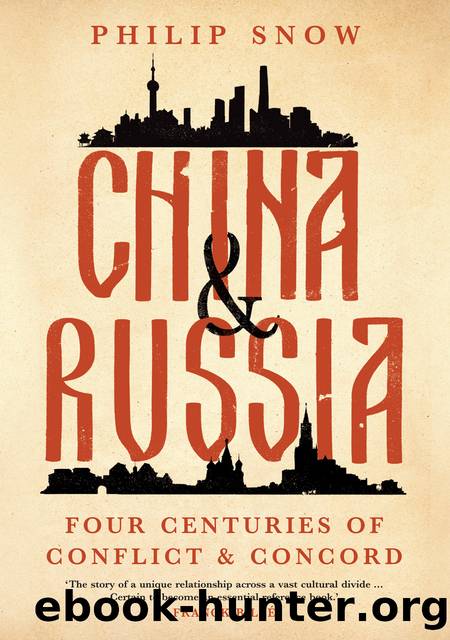China and Russia by Philip Snow;

Author:Philip Snow;
Language: eng
Format: epub
ISBN: 9780300271799
Publisher: Yale University Press
RUSSIA RESURGENT (1943â5)
Against all apparent Chinese expectations the tide of war turned. In January 1943 the German Sixth Army were surrounded and captured at Stalingrad by the Soviet Red Army under the leadership of, among others, Zhukov and Chuikov. In July, in the greatest tank battle in history, Zhukov broke the back of the Wehrmacht at Kursk. In 1944 the Red Army fought their way back to the pre-war Soviet border and onwards into Central Europe; and in May 1945 Chuikov received the surrender of the remnant Nazi force in Berlin. Horribly bloodied but stronger than ever, the Soviet Union had emerged from the cataclysm and was once again turning its thoughts to the East.
The old dread of a Japanese stab in the back had at long last abated. On 10 October 1943 Vladimirov observed in his diary, âAlthough the [Japanese] Guandong Army is deployed near our frontiers, the war threat for the Soviet Union in the Far East has disappeared.â178 But Stalinâs strategic attention was not letting up. His eye had been caught by a potential new menace in the form of his nominal ally, the United States, which was for the first time establishing a major military presence in China with the full support of its KMT protégés. How long was it likely to be before US forces were stationed in the Chinese borderlands? In September 1944 Stalin ordered his General Staff to start planning the concentration and supply of their troops in the eastern part of the country, and at the end of the year Vladimirov recorded, âThe time is now near when the Soviet Union can take measures to protect its frontiers in the Far East.â179 The victorious Russians were also in desperate need of the mineral and industrial resources with which to rebuild their shattered economy. The Chinese borderlands, as they well knew, contained both; but their grip on those borderlands had been largely broken by the geopolitical upheavals of recent years.
Xinjiang was a case in point. Soviet troops and advisers had scarcely been expelled from the province before the American bogey was rearing its head. By April 1943 the Nationalist government were urging their US friends to set up a consulate in Urumqi âto watch out for the Soviet Unionâ,180 and an American consulate (along with a British one) was duly established there. By spring 1943 too the Americans with Chungkingâs blessing were pressing the Kremlin to let them transport war supplies for the Chinese along the land route which ran from Iran through Soviet Central Asia and into Xinjiang, to make up for the Japanese occupation of the Burma Road. The Kremlin demurred on logistical grounds; but the Americans continued to press. In late 1944 they were seeking permission for a convoy of 500 trucks carrying arms plus 1,000 US military personnel to cross the Soviet Central Asian republics to the Xinjiang border town of Yining. Such an itinerary would bring a US presence into the heart of Xinjiangâs north-western Three Districts, that
Download
This site does not store any files on its server. We only index and link to content provided by other sites. Please contact the content providers to delete copyright contents if any and email us, we'll remove relevant links or contents immediately.
| Anthropology | Archaeology |
| Philosophy | Politics & Government |
| Social Sciences | Sociology |
| Women's Studies |
The Secret History by Donna Tartt(18246)
The Social Justice Warrior Handbook by Lisa De Pasquale(11965)
Thirteen Reasons Why by Jay Asher(8481)
This Is How You Lose Her by Junot Diaz(6466)
Weapons of Math Destruction by Cathy O'Neil(5864)
Zero to One by Peter Thiel(5512)
Beartown by Fredrik Backman(5375)
The Myth of the Strong Leader by Archie Brown(5252)
The Fire Next Time by James Baldwin(5035)
How Democracies Die by Steven Levitsky & Daniel Ziblatt(4973)
Promise Me, Dad by Joe Biden(4916)
Stone's Rules by Roger Stone(4876)
100 Deadly Skills by Clint Emerson(4705)
A Higher Loyalty: Truth, Lies, and Leadership by James Comey(4569)
Rise and Kill First by Ronen Bergman(4555)
Secrecy World by Jake Bernstein(4411)
The David Icke Guide to the Global Conspiracy (and how to end it) by David Icke(4403)
The Farm by Tom Rob Smith(4335)
The Doomsday Machine by Daniel Ellsberg(4255)
